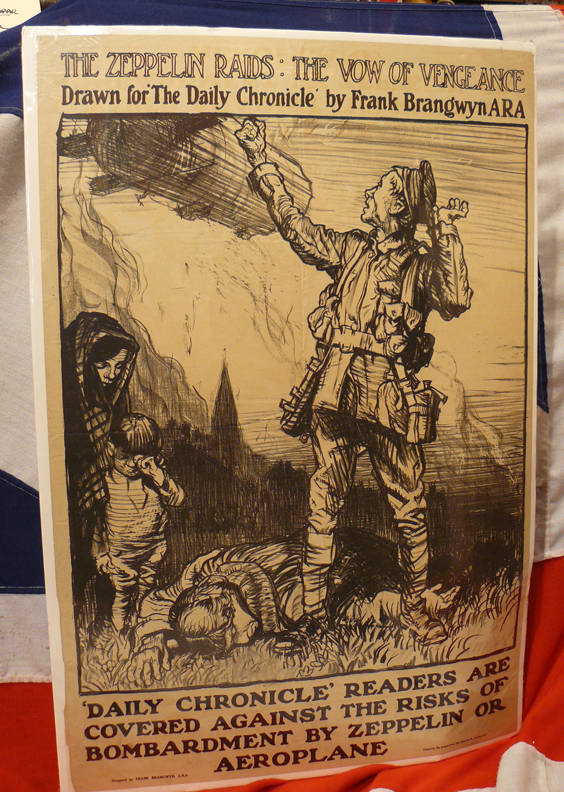A Most Fine and Rare Original Frank Brangwyn WW1 Propaganda Poster. A Superb Piece Of Original Historical WW1 Artistry,Ideal For Interior Decor
This is a superb original work of art that would look simply amazing framed and placed in the right setting.
After the June 1915 raids, when air raids intensified, the Daily Chronicle offered its readers £150 for damage to homes and their contents by hostile aircraft, £100 for fatal injuries, £30 for damage inflicted by the enemy but not by air power and £10 to cover medical fees for non-fatal injuries.
The Zeppelin Raids: the vow of vengeance. Drawn for "The Daily Chronicle" by Frank Brangwyn A.R.A. 'Daily Chronicle' readers are covered against the risks of bombardment by zeppelin or aeroplane.British infantryman, full-length standing figure, looking up and shaking his fist at a departing Zeppelin. At his feet lies the body of an old woman who is mourned by a small boy and woman, left. In the background a skyline of bomb damaged and smoke shrouded buildings text: "THE ZEPPELIN RAIDS: THE VOW OF VENGEANCE Drawn for 'The Daily Chronicle' by Frank Brangwyn ARA" (in 2 lines upper edge) & "'DAILY CHRONICLE' READERS ARE COVERED AGAINST THE RISKS OF BOMBARDMENT BY ZEPPELIN OR AEROPLANE" printed by The Avenue Press, Ltd., Bouverie St., London, E.C. Original lithograph poster.
There are other original surviving examples of this original poster in both the Imperial War Museumin London and the Library of Congress in America. Posters of this kind are rare simply due to the fact they were considered as disposable propaganda artworks and were thus disposed of when no longer needed after the wars end. Brangwyn trained at the Royal College of Art, and was an apprentice with the designer William Morris. A highly regarded and prolific draughtsman, he was an established Royal Academician by the beginning of the First World War.
Frank Pick, General Manager of London Underground and a notable supporter of high quality design, commissioned Brangwyn to produce morale raising posters for London commuters. Brangwyn also worked extensively for war charities, producing many posters in support of Belgian relief, as he had been born in Bruges. Later in the war he contributed to the Ministry of Information's print series 'Efforts and Ideals' and designed posters for the National War Savings Committee.
His emotive realism was often criticised by government officials for demoralising the public. His depiction of close combat in the War Savings poster 'Put Strength in the Final Blow' was published only after some debate. The poster caused a public outcry in Germany, but ironically Brangwyn's reputation was considerably higher on the Continent. He was featured in an illustrated article in the prestigious German poster journal, Das Plakat in 1919.
Moved by the suffering and destruction of the war, Brangwyn later became a pacifist. His career continued to flourish after the war, most prominently as a painter of murals for public buildings. He is celebrated in the Brangwyn Museum in Bruges and the Musee de la Ville at Orange, France also has large holdings of his work. During World War I, the impact of the poster as a means of communication was greater than at any other time during history. The ability of posters to inspire, inform, and persuade combined with vibrant design trends in many of the participating countries to produce interesting visual works. At the start of the twentieth century he was the one British artist whose work was revered by the European cognoscenti, and the Japanese recognised in his artistic endeavours a love of simplicity, geometric compositions, and clarity of colour. He worked for Bing and Tiffany and produced murals for four North American public buildings. A supremely charitable man with a reputation for being irascible; a pacifist whose brutal WWI poster Put Strength in the Final Blow (1918) reputedly led the Kaiser to put a price on his head.
The man whom G K Chesterton described as
‘the most masculine of modern men of genius’ could also produce exquisitely delicate and serene works like St Patrick in the Forest (Christ’s Hospital murals); and his oils are as voluptuous in colour and form as his furniture is minimalist. Original WW1 and WW2 Posters are becoming hugely popular yet some are still very affordable, prices for nice examples are reaching well into the thousands over the past few years now. If a 1920's Russian movie poster of the Battleship Potemkin will fetch over £100,000 GBP, the potential for the values of fine propaganda posters by the great artists of their day could be immense 20 x 30.25 inches
Code: 22667
625.00 GBP


